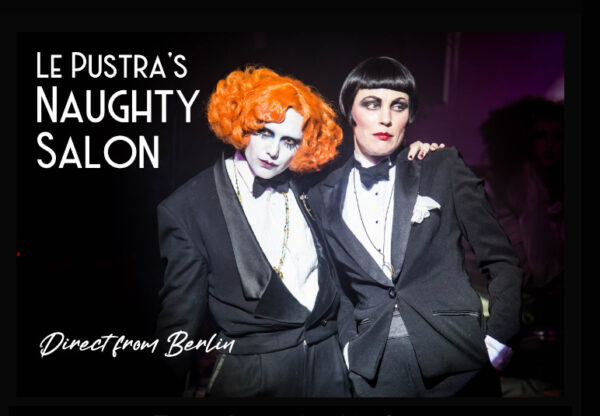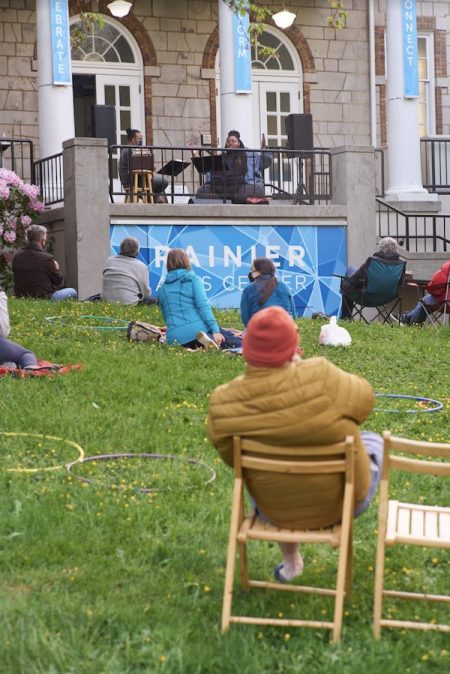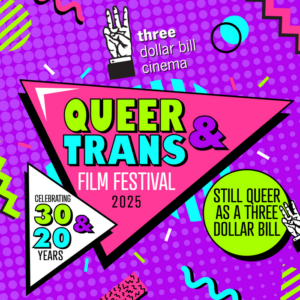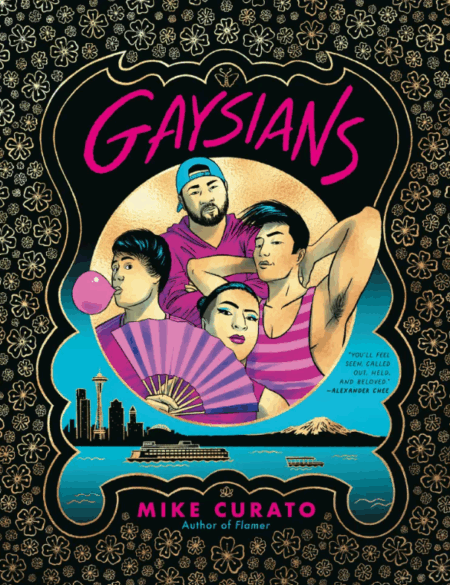The Williams Project, led by director Ryan Purcell, has been bringing unique theatrical experiences to actors and audiences in Seattle from Tennessee Williams’ Orpheus Descending with Intiman to their most recent exploration of Lorca’s Blood Wedding performed throughout a variety of site specific spaces at the Equinox Studios in Georgetown.
I got to sit down with Ryan during tech week of their current production of Tony Kushner’s 1985 play, A Bright Room Called Day – a theatrical political call to action that hopes to inspire as it entertains – and chat about what makes The Williams Project different, how they choose their projects, and the perks of working in a yurt.
Rachel Delmar: I love what you guys do.

Artistic Director of The Williams Project and director of “A Bright Room Called Day”, Ryan Purcell. Photo: Jeff Carpenter
Ryan Purcell: Thank you it’s a lot of work but I think it’s worth it. We are proud of it.
Rachel: It’s unique too. The experiences you give actors and the experiences you bring to audiences as well. Tell me what this one is going to be.
Ryan: Tony Kushner’s A BRIGHT ROOM CALLED DAY. Which is a brilliant and disturbing and funny look at how we should behave in dangerous times. It’s a group of artists, bohemians, and political folk in Berlin in 1932. One of the big questions the play asks is that now that we as a modern audience now know where it all goes, it is easy for us to understand what the stakes are and what decisions make sense and what the right thing to do is. But at the time it’s much more messy and gray and ambiguous. So it’s a lot like now, unfortunately, with what’s going on with Trump. Which is like, there is still this part of me, and I think a lot of people who are like well, we don’t know how bad it is going to get let’s do our best but also there is this real chance that things could get really really bad if we’re not careful. So the play is really a call to action about how to get involved, how to stay connected to your community, to the people you care about, and how to fight back in a way that is not didactic but is still very theatrical.
Rachel: Is this a project you wanted to do for a while or is it something more recent. I’m curious how you pick projects.
Ryan: It’s sort of all over the map. I work with the same people a lot. And they have brought me the plays that they say, this feels like a Williams Project play. So this one, we had a workshop in January. We just read it and immediately we were like, yeah this is the one. Not only because of how relevant it feels. There are a lot of plays that are politically relevant right now but I think what really struck us was how much it felt contemporary. Felt very much like Seattle. It really just jumped off the page. The last thing I want to do is a political play that’s boring. You know, teaching people a lesson. But that’s not this. There are no easy answers in it.
Rachel: You said it felt like a Williams Project play. What else does that feel like to you? What does it encapsulate?
Ryan: We have found that it is a couple things. It always has incredible language. Whether because someone is a great poet or a great thinker usually both so that when we have these incredible actors who are able to make it honest it doesn’t shrink. Honest but still epic. They are usually plays that were not successful when they premiered. I think that’s because they are always plays that look on the surface to be sort of naturalistic & easy but in reality they are much weirder & messier. Part of what I think we do really well is we take these plays that are a little off center and explode what’s really going on. So they almost never fit into the clean box of what genre it is. This is a living room drama when you look at the stage directions, it all takes place in a living room, but actually there are political speeches in it, there are incredibly theatrical moments of the devil showing up, there are personal explorations of politics, so they blend all of these different genres together. Another thing I think our plays always try to do is they look at, and try to complicate what we think of as identities that we understand. So, in terms of this play, there’s a way that we think about Germany before World War II that I think is sort of fun to explode and look at what if everyone was a real person just like you and me like living these very different lives with different identities but still trying to solve this problem. So that’s another element TWP always tries to do. It’s a lot.
Rachel: Another thing I think of TWP being known for is your process. Would you share an insider perspective what it was like this time?
Ryan: We go away from 10 days to 2 weeks. The initial idea was just that it was a way to get people fully engaged in the work. We also had a lot of people from out of town. It was logistically easier in the first year. But what we learned from that was that when people live together, when they eat dinner together every night, they develop a sense of ensemble that is really relaxed.
This year was hilarious. We rehearsed in a yurt. We were out at this retreat center in Ocean Shores that was in the middle of nowhere so you’re just stuck with each other. You wake up in the morning you go to rehearsal you work all day you open a bottle of wine eat dinner together and go to sleep and sometimes you watch a movie. This time we watched Hereditary and it was a huge mistake. It freaked everybody out. So that’s the idea. It is a little bit like summer camp mixed with really rigorous work.
Rachel: To me, and I think many other artists, that sounds like living the dream. To run off to a cabin in the woods, or in this case to a yurt on the beach. There are clearly so many benefits do you see there being any downside at all?

The cast of “A Bright Room Called Day” in rehearsal in that yurt at Ocean Shores, WA. Photo via Facebook Page for The Williams Project
Ryan: There’s the downsides you never think about.
10 people. 2 showers.
The biggest challenge is because you pull people away and you let it be their entire focus, one of the challenges is that works really well when the run is short and you can just continue in that energy. But how you translate that into something sustainable that becomes a normal show. You create a very special environment and then you come back and have to deal with all the other things that are making art. The bumping up against reality that has to happen. It’s difficult but I think it is worth it.
Rachel: So, doing this play, during this time in our country have you seen that affect the atmosphere of the room? It is obviously different than it would have been 4 years ago. How has that been for y’all?
Ryan: It’s sort of like a distilling how it feels to be alive right now. But I think the biggest thing I’ve learned from working on this play is how much building this ensemble feels like the model of building a resistance.
The thing Tony Kushner does really well here is that he doesn’t minimize the stakes or the danger but he does have a lot of compassion for why people choose the wrong thing, or don’t work as hard as they can. So how do you stick to your guns and work hard and be passionate and not let people off the hook for their shit. The racism, the xenophobia, the hatred. Don’t let people off the hook but still maintain a sense of love for the world that is necessary for real change.
Rachel: Why this play, why here, why now?
Ryan: I trusted this was a work of art. I read a lot of history and political theory books and then I’d read the script and think about how it felt like it was happening right now in Seattle. I started to try to build a world that was authentically both. How do we create a world that could be 1932 Germany, and that is absolutely Hillman City in 2018 as I’m watching it. That’s a lot of looking at art, images, and walking around and looking at my neighborhood. How do I bring what’s outside the building inside so it doesn’t feel like you’re stepping into a theatre. It feels like you’re continuing the conversation that you’re living but in a very distilled and heightened way for a couple hours.
Rachel: What a beautiful way of bringing art to a neighborhood & making it relevant to the people here.
Ryan: That’s why we also have these partnerships with activist groups because again our mission generally is that art, if it’s great, really engages you and there should be options for doing more from that. It’s not always political but it’s about connecting to other people not just the work itself. We always think about where we are going to be in a way that’s different than a lot of other theatre companies. This play takes place in a living room that becomes a political activist place and this space is literally a room that feels like a living room but is a political activist space and a community gathering space and a church. So there is something energetic and sort of spiritual about matching up a place that already has this energy going on and taking it further with art.
Rachel: I felt that way at Blood Wedding at Equinox Studios. I didn’t know that place even existed. I love when theatre, art, anything, brings me to a new place I get to explore. That does feel activated by what you’re doing.
Ryan: Part of the mission with that one was that is a play about beauty and nature existing amongst us and to have all of these visual artists right there – communities can be very separate – so put it together and let people know what this city has going on.
Rachel: What has been the most interesting or unexpected discovery as you’ve been playing.
Ryan: Two things. The biggest discovery about the play itself is that it was written in 1985 but it predicts Trump not just politically but personality and culture. So that discovery that, oh this is not about HIS personality, it’s about a certain system and cultural thing that leads to people wanting this authoritative presence and that is not unique. I think we all want to think of our time as exceptional but the big discovery is that it’s very by the book. Trump coming into power did not feel by the book. But, it’s just a different book.
The other fascinating discovery is going back to the idea that the energy with which we treat each other in the play and in the room really affects whether we leave dispirited or really empowered. It’s been surprising to do the same play two different days in a slightly different mood and it feeling totally different. I think this play, which is shocking to say about a play that traces the rise of fascism, unfolds in a way that says – this is up to you.
Rachel: Another thing I think about when I think of TWP is that you take big risks, make some really bold choices, for better for worse. Are there any for us to look forward to in this one?
Ryan: I think one big risk we’re taking this time is acknowledging that this play is a public event. In tech, you learn a lot and we learned that the lights are just going to be on. So, the biggest risk we’re taking is saying this a fully public interchange there is not a level of scene by scene watching it unfold it constantly reengages and that’s scary. Because I’m sitting here acting and you’re sitting there in the audience and we are very close and looking at each other and there is no distance.
Another big risk that I think is paying off is the way we are blending times. It is going to make the 30s in Germany feel a lot like now and that’s really a dangerous thing to be in the middle of. And of course there are the bells and whistles we’re putting on it. There are some strange aesthetic choices that are very much in line with what I care about. I believe in POP as a genre. I believe in the Ridiculous as a genre. And both of those are very present in this play. And I believe in juxtaposition, so things that do not naturally flow together being smashed together. And there are some fascinating smashings.

Photo credit: Marcia Davis, That Davis Girl — with Claudine Mboligikpelani Nako, Dedra Woods, Grant Chapman and Lateefah Holder.
Rachel: What, with all the “smashings”, do you want your audience to walk away and do and talk about?
Ryan: I want the audience to be jolted. There’s the thing if you a frog in cold water and slowly heat it up it will sit there but if you drop it into boiling water it will jump out because it’s shocked. It feels it immediately. I think at a time when we are moving in this dangerous direction one step at a time the idea is to remind people of the power of community and the power of action. And to give them that jolt of being dropped in boiling water. That sounds a bit more tortuous than the actual experience. Part of why it is jolting is because of how much fun when they have when in community. Part of the danger of times like this is that it makes you feel like reality is what’s on Facebook. As opposed to what’s in front of you in your relationships. So, the goal is that they come and are reminded of life giving power of being together, working together, and taking action. And then that they do something with that. The play and I don’t know exactly what’s right but I think the play and I would both agree that’s not an excuse to not figure it out for yourself.
Rachel: You mentioned earlier you have partner organizations, who are they?
Ryan: One of the things the play and the history brings up is that authoritarians and fascists start by attacking very vulnerable people. Part of the danger of a liberal city like Seattle is that we’re like – We are not Trump people, you know, we’re already doing a lot. In a way that’s true but if we look at who is vulnerable in this city. You look at the homeless crisis. What’s happening to organized labor. To immigrants. Those are all in the play. In a slightly different way. We wanted to engage those issues in a fuller way. So we are working with Plymouth Housing, Northwest Immigrant Rights Project, and 21 Progress.
People from the organizations are going to talk after each show for a couple of minutes about what they do. To say, if you want to get involved, if you’re looking for something to do these three organizations are three good examples. We’re not going to give you a lecture. But you just saw this play and if in this moment of connection you want to take one more step here’s an option.
We keep asking, what can we do right now? We can work to help vulnerable people.
Rachel: I love giving the action item. We have talked the talk, here is how you can walk the walk. A clear, here’s the next step after you leave the theatre.
Ryan: Exactly. One of the things we constantly struggle with is none of this works if the play is not good. And we know that. Right?
Rachel: Right.
Ryan: So, a lot of our framing is around the action and the event but a lot of our work in the Yurt and getting great professional actors and paying them enough to focus on the work while they’re doing it is to also to make sure that it is not an intellectual exercise. It’s a full human experience.
Rachel: Absolutely. Give me the elevator pitch.
Ryan: Art is great at distilling the moment you’re in. Whatever you’re feeling about this moment we’re in, this play has diamond sharp vision into what’s really going on. And does it in a way that opens your heart up and inspires as opposed to shutting down and closing off. So it’s a great night to engage with what’s going on in our lives right now.
Rachel: Can’t wait.
Ryan: Thanks.
Rachel: Thank you.
The Williams Project’s production of Tony Kushner’s A BRIGHT ROOM CALLED DAY runs October 25th through November 18, 2018 at Hillman City Collaboratory, 5623 Rainier Avenue South. Tickets available HERE!
A new president has just come to power by the slimmest of margins. Though his rhetoric is alarming, democratic institutions are strong and the opposition is looking good heading into the next election. This is Berlin, in 1932. In Agnes Eggling’s apartment, a group of artists and activists struggle between their conscience and their comfort, trying to decide how much they are willing to sacrifice for their beliefs.
First produced in 1985, this prophetic play by Pulitzer Prize and Tony Award-winning playwright Tony Kushner is a wake-up call and warning for contemporary America, posing timely questions about citizenship, resistance, and complicity. Building upon The Williams Project’s commitment to making theatre that sparks civic discourse and connects communities, performances will feature partnerships with other local non-profits, highlighting for audiences ways of becoming more politically engaged.

















